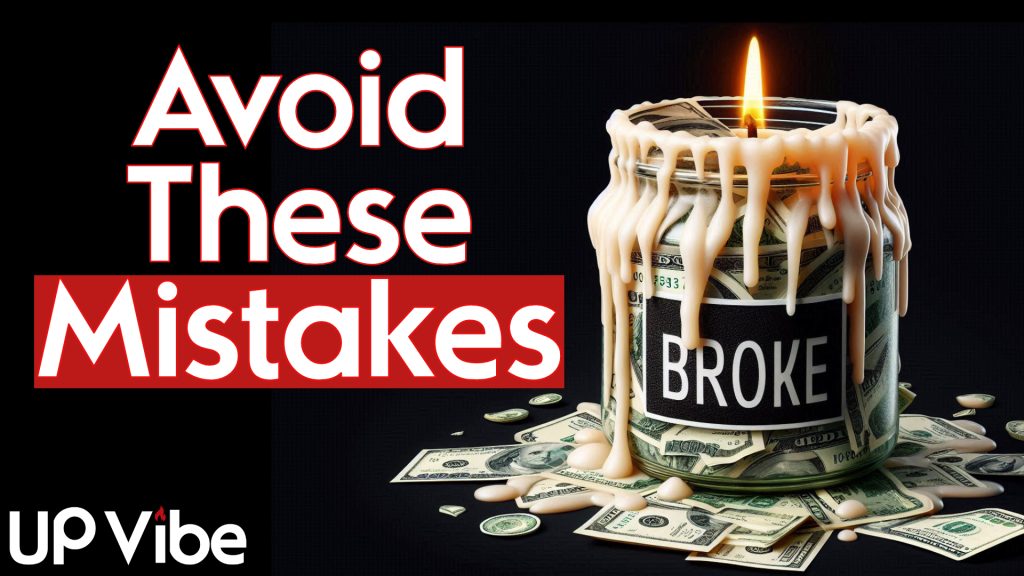
5 Things Not to Do with Your Candle-Making Business
Over the years, I’ve helped students (and myself) make more money in the candle-making business—not by following some secret formula—but by avoiding five major mistakes.
Now let’s break this down…
1. Neglecting Your Branding
Branding Isn’t Just a Logo
A lot of newbies—and yes, even some seasoned candle folks—treat branding like it’s a checkbox. Got a name? ✅
Made a logo? ✅
Cool. Business is branded.
Nope.
Branding goes way deeper. It’s the emotional connection your audience feels when they experience your business. It’s the vibe, the trust, the story. Without it, your business is just a transaction machine:
Make candle. Sell candle. Repeat.
That’s not bad… but it’s not memorable either.
What I Did with UP Vibe
From the beginning of UP Vibe, I knew branding had to be a priority. I spent time creating a tone, a look, and a message that would resonate with a specific person—you.
I chose colors on purpose. Fonts on purpose. The words I use? Yup—those too. Everything was designed to be consistent, authentic, and recognizable.
Most Candle Brands Miss This
Here’s the hard truth: most candle makers I see don’t have a brand. They have a business. And while I truly wish them success, the reality is, businesses without branding often fade out.
It’s like playing hide-and-seek when nobody’s looking for you.
Branding gives people a reason to care about your product—beyond the scent.
Your Move
My goal here isn’t to overwhelm you with branding talk. It’s to help you think about how branding plays a role in your candle-making journey.
Because if you’ve watched more than one of my videos (or made it this far in the blog), that’s already proof that strong branding doesn’t just attract—it keeps people around.
Stay tuned for mistake #2… it’s a spicy one.
2. Ignoring Customer Feedback
Let’s get one thing straight—customer feedback is gold, especially when you’re starting out. Yet, too many candle makers treat it like a suggestion box in the corner of a forgotten office. Big mistake.
One of the most common questions I see floating around in candle-making Facebook groups is:
“What should I do if something goes wrong with a candle I made, but it wasn’t my fault?”
Now, here’s the honest truth:
Even if it wasn’t your fault—like, 100% not your fault—what do you gain by refusing to send a new candle?
Actually, better question: What do you lose?
Let’s Do the Math
Say it costs you $3 to make a candle and $5 to ship it. That’s $8 total.
If you send a replacement, you’re now in $16 deep—$8 for the original, $8 for the do-over.
Now, let’s say your customer paid $25 for that candle.
Even after the replacement, you’ve still got a $9 profit.
But if you decide to play hardball and argue your case like a courtroom drama, you risk a whole lot more—your reputation, the customer’s future business, and the possibility of positive word-of-mouth.
You’re Running a Business, Not a Blame Game
Look, I get it. Sometimes it feels like customers are being dishonest or trying to get a freebie. But unless you’ve got concrete proof (pun intended), is it really worth the time, stress, and potential backlash to stand your ground?
When something goes wrong with a customer order, I don’t sit around stewing.
I fix it. Quickly. No overthinking. Why? Because:
-
The headache isn’t worth it
-
The time lost isn’t worth it
-
And most importantly—the future business from that customer is worth it
Think about it: A happy customer is more likely to come back, leave a glowing review, recommend you to others, and become a loyal part of your brand story.
Do you really want to risk all that… over $16?
It’s Not Just About Replacements
Customer feedback isn’t just about damage control. It’s an open door to build trust, connection, and loyalty.
Whether they’re giving praise, constructive criticism, or asking for something you hadn’t thought of—listen.
When customers feel heard, they’re not just buying candles anymore—they’re buying into your brand.
So the next time a candle goes rogue or a shipment gets a little wild, don’t panic. Handle it with care. Because in this business, lighting up someone’s day is worth way more than watching your profit margins go up in smoke.
3. Underpricing Your Products
Let’s talk about something that trips up a lot of candle makers—pricing.
It’s not always easy to figure out what to charge. Trust me, I’ve been there. You want to stay competitive, you want people to buy, and maybe—just maybe—you’re afraid to charge too much and scare customers away.
But here’s what I’ve learned over the years:
Price your products for value—not to win the bargain bin battle.
Underpricing Doesn’t Help You
When you price too low, you’re not doing your customers a favor. You’re actually sending a message:
“My work isn’t worth much.”
And that message?
It sticks.
It creates a perception that your candles are cheap—not just in price, but in quality.
Worse yet, it attracts the wrong kind of buyer—bargain hunters who care more about saving a few bucks than appreciating your craft.
People Want to Pay for Value
This might sound wild, but it’s true:
A lot of people actually want to spend more.
As long as they feel like they’re getting something special, something thoughtful, something worth it… they’ll pay.
But the second they feel like they’ve been taken advantage of?
It’s over.
You lose their trust, their future business, and possibly their five-star review. And we both know how important those are.
Pricing = Perception
Let’s break it down like this:
Ever meet someone amazing who’s still single and immediately think,
“Wait… Why are they still single? What’s wrong with them?”
That little question mark in your brain is about expectation.
It’s the same thing with your candle prices.
When your pricing doesn’t match the experience or quality you’re promising, people start second-guessing. Even if your product is great, that disconnect can scare customers off.
And here’s the kicker:
If your pricing doesn’t inspire confidence, your customers will walk. Quickly.
So… What Should You Do?
Stop pricing like you’re running a clearance rack at a dollar store.
Your time, your creativity, your materials—they all matter. They all add value.
Charge what you’re worth.
Because if you don’t believe your candles are worth the price, why should anyone else?
When you price with purpose and confidence, your audience will feel that. And the right ones will pay, stay, and keep coming back.
4. Lacking a Consistent Social Media Presence
Let me get straight to the point:
I make money because of social media.
Not trying to brag. Not trying to flex.
Just making a point.
While most people are scrolling (my kids included), I’m writing scripts.
While others are craning their necks to catch the latest viral reel, I’m editing video.
And while many are reposting memes, I’m over here checking analytics.
Is Social Media Easy? Nope.
Let’s not sugarcoat it—social media is not a walk in the park.
You can pour your soul into a reel that you swear is your best work ever… and crickets.
Then you toss together a half-baked clip at the last minute—and boom. It takes off like your grandma’s gossip at Sunday dinner.
Frustrating? Oh yeah.
Predictable? Never.
Worth it? Always.
Because here’s the truth that most people miss:
Consistency beats perfection. Every. Single. Time.
Think of Social Media Like a Garden
Some posts will sprout. Some won’t.
But if you don’t keep planting… you’ll never grow a thing.
And this isn’t just any garden—we’re talking a financial garden.
That’s the type of growth you want. One that pays your bills, fuels your passion, and funds your next batch of concrete jars.
Don’t Chase Likes. Chase Trust.
Yes, views, likes, and shares feel great. But that’s not the goal.
The goal is to keep showing up. When you do that consistently, your audience starts to recognize you. Then they start to trust you. And trust, my friend, leads to sales, loyalty, and long-term success.
So even if it feels like nobody’s watching? Someone always is.
Lurking. Listening. Deciding whether you’re the real deal.
And let me say this loud and clear:
The biggest mistake on social media is not posting a flop…
It’s not posting at all.
5. Not Tracking Your Finances
When I first started, I’ll be honest—numbers weren’t my thing.
I had passion. That was enough, right?
After all, it’s supposed to be about the craft, the creativity, the art of it all.
But here’s the reality check I didn’t see coming:
Passion doesn’t pay the bills.
And not tracking your finances?
Yeah, that’s like building your dream candle studio… on a sinkhole.
I Learned the Hard Way
There was a time—early on—when I was so focused on making the perfect candles, I had no clue what each batch was even costing me.
I’d say things like,
“Eh, I’ll just sell a few, cover expenses, and I’ll be fine.”
Spoiler alert: I wasn’t.
It’s Not Just About Profit and Loss
Tracking your finances isn’t only about how much you made (or lost).
It’s about spotting the opportunities you’re missing:
-
Where can you cut waste?
-
Which materials give you the best value?
-
Is it time to reinvest or pull back?
When you actually understand your numbers, you make smarter decisions—not just emotional ones.
I Know—Numbers Aren’t Fun
Look, I get it. It’s way more exciting to play with new scent combos or come up with cool names like Midnight Meltdown or Citrus Chaos.
But if you’re serious about running a real business, your finances need to be tight.
And please… don’t rely on “mental math.” I tried that too.
It doesn’t work.
You’ll lose track faster than a sock in the laundry.
Use a Spreadsheet or App—Your Sanity Will Thank You
Once I got a handle on things—knowing my cost of goods sold (COGS), tracking revenue, calculating profit margins—my business stopped feeling like a guessing game.
I even made a video to walk through the process so others don’t fall into the same trap.
And here’s the best part:
I started making more money.
Because I knew how to price with purpose—not fear.
So let me say this loud and clear:
Running your business without tracking your finances is like driving blindfolded.
You might get somewhere, but chances are…
it won’t be where you wanted to go.
Final Thoughts
If you’ve made any of these mistakes—welcome to the club. I’ve made them all.
More than once.
But that’s the beauty of business: you don’t have to get it perfect.
You just have to keep learning, adjusting, and showing up.
Let’s recap the 5 things not to do in your candle business:
-
Ignoring Customer Feedback – Handle problems fast, build trust faster.
-
Underpricing Your Products – Your prices reflect your value. Don’t sell yourself short.
-
Lacking a Consistent Social Media Presence – Post even when it’s not perfect. Just don’t disappear.
-
Not Tracking Your Finances – Know your numbers so you can grow your profits (and your peace of mind).
-
Treating This Like a Hobby When It’s Supposed to Be a Business – (Okay, that’s a bonus sixth one—but you get the point.)
The truth is, running a candle business is more than just wax and wicks.
It’s marketing. It’s branding. It’s customer experience.
It’s a full-blown business.
And if you treat it like one, it can reward you like one.
So take a breath.
Check your pricing.
Track your numbers.
Show up for your audience.
And always—always—listen to your customers.
Now light that wick and let your business burn bright.
If you’d like to see the full video version please click here.



0 Comments